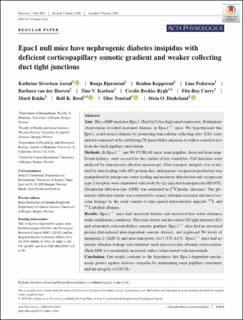| dc.contributor.author | Åsrud, Kathrine Sivertsen | |
| dc.contributor.author | Bjørnstad, Ronja | |
| dc.contributor.author | Kopperud, Reidun Kristin | |
| dc.contributor.author | Pedersen, Line | |
| dc.contributor.author | van der Hoeven, Barbara | |
| dc.contributor.author | Karlsen, Tine Veronica | |
| dc.contributor.author | Rygh, Cecilie Brekke | |
| dc.contributor.author | Curry, Fitz-Roy | |
| dc.contributor.author | Bakke, Marit | |
| dc.contributor.author | Reed, Rolf K. | |
| dc.contributor.author | Tenstad, Olav | |
| dc.contributor.author | Døskeland, Stein Ove | |
| dc.date.accessioned | 2021-04-22T10:29:39Z | |
| dc.date.available | 2021-04-22T10:29:39Z | |
| dc.date.created | 2020-07-29T13:17:31Z | |
| dc.date.issued | 2020 | |
| dc.Published | Acta Physiologica. 2020, 229 (1), . | |
| dc.identifier.issn | 1748-1708 | |
| dc.identifier.uri | https://hdl.handle.net/11250/2739090 | |
| dc.description.abstract | Aim
The cAMP‐mediator Epac1 (RapGef3) has high renal expression. Preliminary observations revealed increased diuresis in Epac1−/− mice. We hypothesized that Epac1 could restrict diuresis by promoting transcellular collecting duct (CD) water and urea transport or by stabilizing CD paracellular junctions to reduce osmolyte loss from the renal papillary interstitium.
Methods
In Epac1−/− and Wt C57BL/6J mice, renal papillae, dissected from snap‐frozen kidneys, were assayed for the content of key osmolytes. Cell junctions were analysed by transmission electron microscopy. Urea transport integrity was evaluated by urea loading with 40% protein diet, endogenous vasopressin production was manipulated by intragastric water loading and moderate dehydration and vasopressin type 2 receptors were stimulated selectively by i.p.‐injected desmopressin (dDAVP). Glomerular filtration rate (GFR) was estimated as [14C]inulin clearance. The glomerular filtration barrier was evaluated by urinary albumin excretion and microvascular leakage by the renal content of time‐spaced intravenously injected 125I‐ and 131I‐labelled albumin.
Results
Epac1−/− mice had increased diuresis and increased free water clearance under antidiuretic conditions. They had shorter and less dense CD tight junction (TJs) and attenuated corticomedullary osmotic gradient. Epac1−/− mice had no increased protein diet‐induced urea‐dependent osmotic diuresis, and expressed Wt levels of aquaporin‐2 (AQP‐2) and urea transporter A1/3 (UT‐A1/3). Epac1−/− mice had no urinary albumin leakage and unaltered renal microvascular albumin extravasation. Their GFR was moderately increased, unless when treated with furosemide.
Conclusion
Our results conform to the hypothesis that Epac1‐dependent mechanisms protect against diabetes insipidus by maintaining renal papillary osmolarity and the integrity of CD TJs. | en_US |
| dc.language.iso | eng | en_US |
| dc.publisher | Wiley | en_US |
| dc.rights | Navngivelse 4.0 Internasjonal | * |
| dc.rights.uri | http://creativecommons.org/licenses/by/4.0/deed.no | * |
| dc.title | Epac1 null mice have nephrogenic diabetes insipidus with deficient corticopapillary osmotic gradient and weaker collecting duct tight junctions | en_US |
| dc.type | Journal article | en_US |
| dc.type | Peer reviewed | en_US |
| dc.description.version | publishedVersion | en_US |
| dc.rights.holder | Copyright 2020 The Authors | en_US |
| dc.source.articlenumber | e13442 | en_US |
| cristin.ispublished | true | |
| cristin.fulltext | original | |
| cristin.qualitycode | 1 | |
| dc.identifier.doi | 10.1111/apha.13442 | |
| dc.identifier.cristin | 1820901 | |
| dc.source.journal | Acta Physiologica | en_US |
| dc.source.40 | 229 | |
| dc.source.14 | 1 | |
| dc.identifier.citation | Acta Physiologica. 2020, 229 (1), e13442 | en_US |
| dc.source.volume | 229 | en_US |
| dc.source.issue | 1 | en_US |

